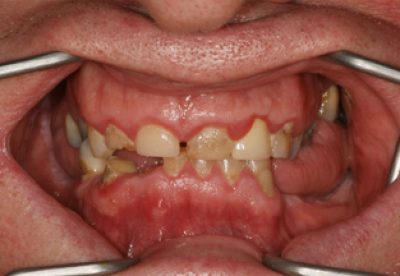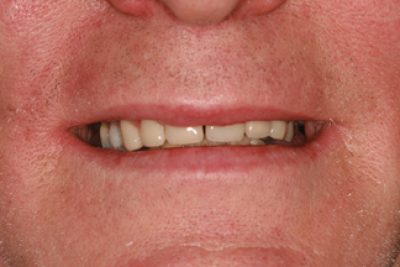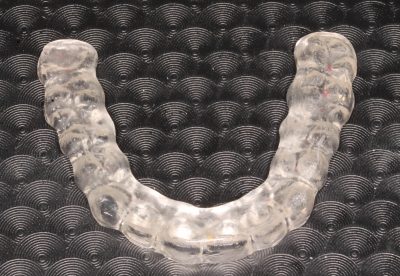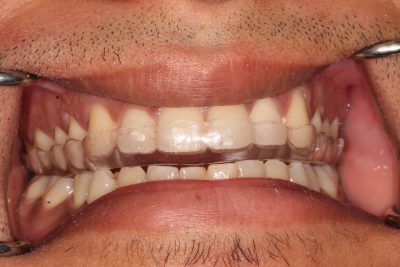Before and After Gallery
Tooth Surface Loss Treatment in London
Tooth wear is a common issue and if you feel that your teeth are worn down, eroded and are flat, this could be a sign you are grinding your teeth or perhaps have too much acid in the mouth. Teeth grinding treatment is a popular option for many. Your dental practice Smile Cliniq in London offers tooth wear treatments against tooth surface loss. Call us to book a consultation today on 020 8090 9077.
Understanding the Causes of Tooth Wear
Tooth wear is caused by damage to the outer layer of the tooth called enamel. When enamel is worn away it exposes the dentine layer underneath which is made up of tubules connected to the nerve of the pulp.
Patients suffering from tooth wear may experience symptoms such as sensitivity to cold and hot drinks and air. The dentine layer of the tooth is much softer than the enamel and wears away at a more rapid rate than enamel. There are various reasons for teeth to become worn – examples include:
Grinding
A common cause of tooth wear is teeth grinding (bruxism), or clenching. People who grind their teeth usually do it at night time in their sleep and often do not know they are grinding. Teeth grinding is often linked to stress. Also known as “Bruxism”, unconscious teeth grinding can become a habit and may still occur unconsciously after the source of stress has been addressed.
An obvious sign you are grinding your teeth is the appearance of flat, level teeth that appear slightly hollowed and darker in the centre.
Acid erosion
Strong acids constantly and frequently in contact with teeth may also cause teeth to erode and wear away. Acids effecting tooth surface loss maybe from citrus fruits, fruit juices and/or fizzy drinks. People suffering from eating disorders or gastric regurgitation may also exhibit erosion to their teeth.
Brushing too hard
Simply brushing too hard or using a hard toothbrush can cause significant wear to your teeth as well as gingival recession. Many people unintentionally brush their teeth too hard to make them sparkly clean when in fact; only slight pressure is required to clean your teeth effectively if the correct technique is being used.
Teeth Grinding Treatment Options
There are various ways to prevent, stop and resolve tooth wear/tooth surface loss. The following are ways of dealing with the causes of tooth wear described above.
Leave and monitor
The advantage of this is no treatment and associated costs, but the disadvantage is the tooth wear may become worse, decreasing the prognosis of the eventual tooth restoration (as tooth structure is now poorer).
Splint
A splint is something that covers the biting surface of your teeth. It is made from hard acrylic that is customised to fit your teeth. The splint works by protecting your teeth when grinding, so you wear down the acrylic instead of your own teeth. It is an effective and quick solution but people who heavily grind their teeth may require replacements. Splints may also help resolve any temporomandibular joint pain or discomfort.
An example of a Michigan’s splint provided in London, occlusally balanced to provide smooth excursive movements, reducing stresses on teeth and the temporo-mandibular joint (TMJ).
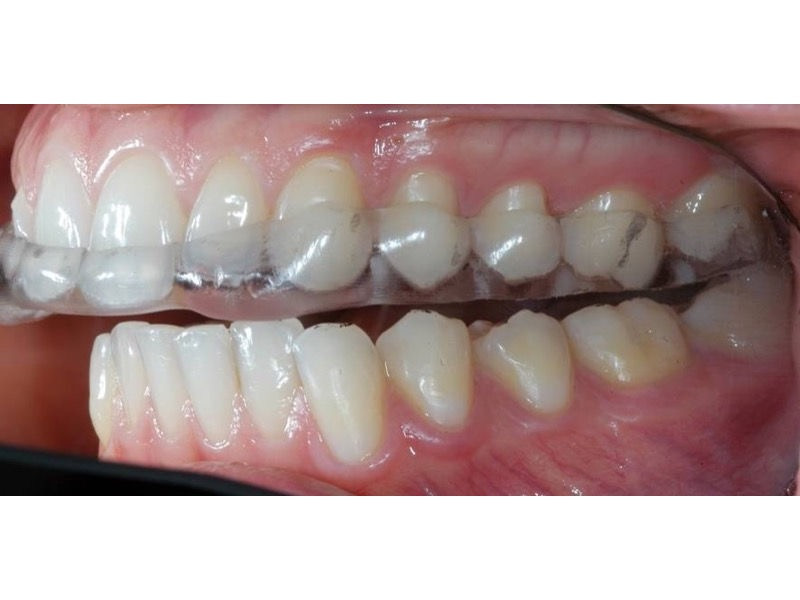
Crowns, composite build-up
Tooth wear causes teeth to look flat, short, and discoloured, and not aesthetically pleasing.
Worn down teeth can be built up using composite white filling material, or the placement of crowns or veneers. Specific shades of these restorations are individually selected to match the rest of your teeth and shaped according to the golden proportion. The best material is used to obtain a natural result and will give you a beautiful smile. Crowns can also be used to cover and protect a heavily restored tooth from breaking apart. There are various materials with different strengths and characteristics. Your dentist will discuss which one is right for you.
Tooth wear treatment for Loss of Canine Guidance
When moving our lower jaw from side to side, normally the canines are in contact, and cause the other teeth to separate and thereby protecting the remaining teeth. Canines have long roots and are designed to handle these excursive movements. Wear and tear on the tips of the canines, often from tooth grinding (called bruxism) allows the top and bottom back teeth to come into contact. This is called “group function”. Group function may lead to fracture of posterior teeth in which have large restorations with thin enamel walls.
To treat this, your dentist may recommend building the canines back up with white composite fillings to regain “canine guidance.” The teeth will initially feel strange as you have been taken back to how the teeth used to be. The overall effect will be to protect your remaining teeth again and decrease splitting forces on the posterior teeth.
Identifying and dealing with the source of stress
Grinding and eating disorders may be caused by stress and depression. Without finding and resolving the causes of stress, it becomes very difficult to stop tooth surface loss. Possible solutions are to talk to a friend, family member or medical practitioner, meditation, delving in to a hobby that makes you feel happy, taking time off work for travel, or visiting a beauty salon/fashion store and building up self-esteem. Each person is different and so some solutions are suited to one more than another. Stress is an ever-increasing problem amongst people currently, but there are many things out there that make life more pleasurable.
Use of correct brush and technique
Many people cause damage to their teeth by simply using the wrong type of brush and technique when brushing. A hard brush will cause trauma to the tooth enamel and gums resulting in tooth wear and recession. Symptoms include hypersensitivity to cold and poor tooth appearance, with cavitation at the tooth-gum interface. It is recommended you use a soft or medium toothbrush, applying a gentle pressure (imagine a force just enough to indent a ripe tomato). Certain electric toothbrushes are also beneficial as they torque out when you are brushing too hard.
The correct technique of tooth brushing can be a little tricky to master at first, but practice makes perfect. Please find the correct technique of tooth brushing by clicking here.
Why Choose Smile Cliniq – London’s Leading Tooth Wear Treatment
Undergoing tooth wear treatment at Smile Cliniq is easier than ever. We book a consultation with you at our clinic the UK to discuss the treatment. We will talk you through the process all the steps involved before you commit to the procedure. Our trained staff are on hand to provide you with everything you need. We make processes such as this as straightforward as possible, all to help you alleviate the symptoms of tooth wear.
To find out more about any teeth grinding treatment and see which option is best suited to your case, please book a consultation at one of our dental practises in London and get an assessment from our experienced dentists.
Tooth Surface Loss Treatment FAQs
Are there different types of tooth wear?
Yes, there are three types of tooth wear and it’s sometimes difficult to determine the type of tooth wear present because some can occur together. They are:
- Abrasion: physical wear of the teeth caused by something other than tooth-to-tooth contact e.g., overzealous, or inappropriate toothbrushing, repeated use of a toothpick or placing hair pins between the teeth.
- Attrition: loss of tooth structure from tooth-to-tooth contact, such as grinding of teeth.
- Dental erosion: dissolving of tooth enamel due to the presence of acids in the mouth.
Are their lifestyle changes that can act as preventative tooth wear treatment?
To help prevent teeth grinding:
- cut back on alcohol because it can make teeth grinding while you’re asleep worse
- give up smoking
- avoid using recreational drugs, such as ecstasy and cocaine
How much do mouth guards and splints cost as part of teeth grinding treatment?
You’ll usually have to pay for a custom-made dental appliance such as a retainer. It’s often a band 3 treatment, but may be more expensive, depending on the type recommended and how it’s made. Ask our team of dentists about the available options and how much they cost.
- Please click here for our fees guide.
- Please click here for examples of our work
- For further details of our techniques, materials and techniques please click here.
- Please click here for our guide to maintaining your oral hygiene.
- Interest free payment options are available
- Return to the top of the page










Finchley
020 3582 8621
St Johns Wood
020 3627 8732
Smile Cliniq Limited. A company registered in England and Wales. Company number 08279068.
Registered office: C/O TG Associates 7 Jardine House, Harrovian Business Village, Bessborough Road, Harrow, Middlesex, HA1 3EX
Terms of Use | Privacy Policy | Health & Safety Charter | Complaints procedure | Data Protection | Cookie Settings
Website by Digimax Dental









